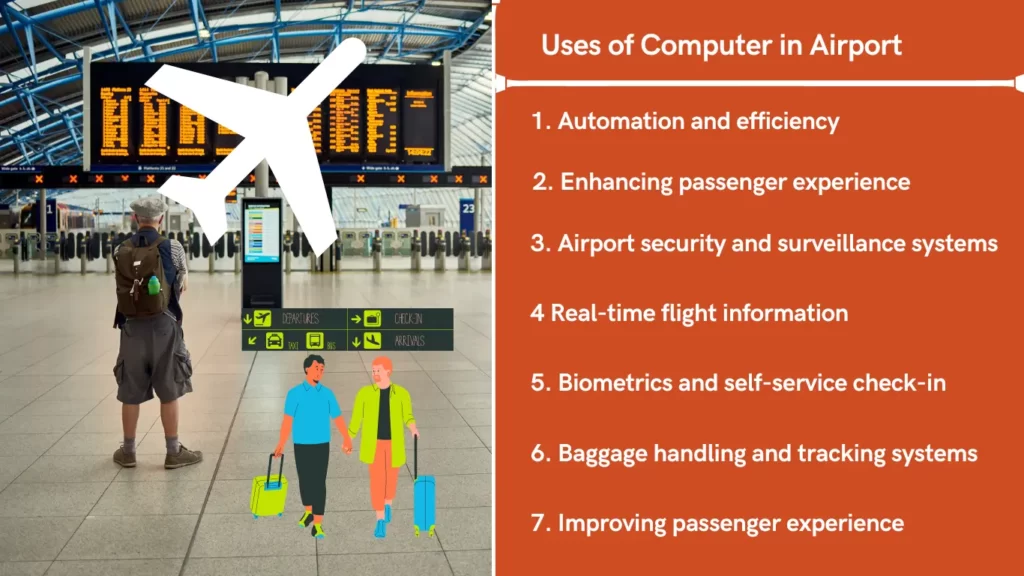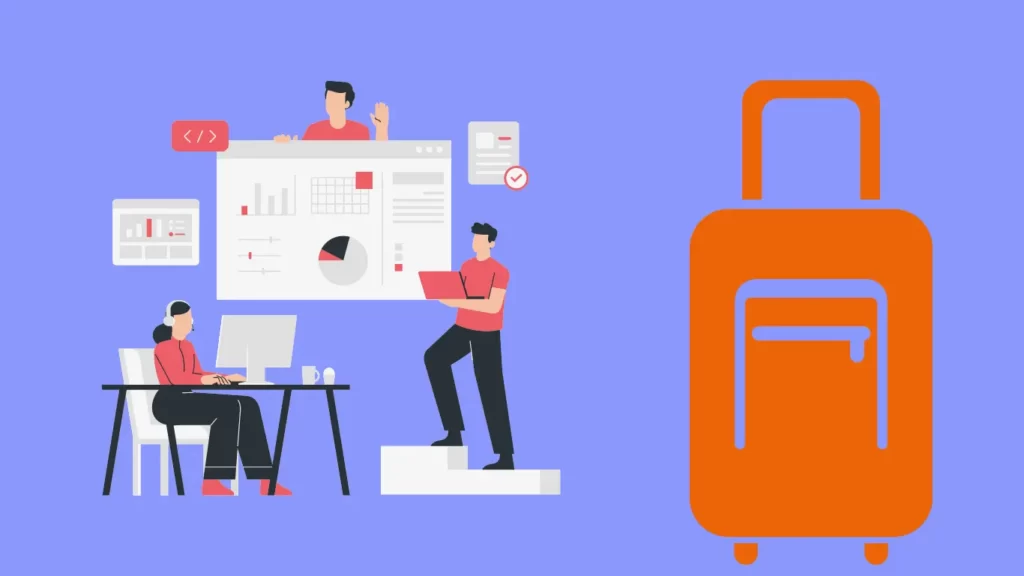Uses of Computer in Airport: Computers had a transformative impact on the aviation industry, particularly in the realm of airports. From automating check-in processes to enhancing security measures, computers have revolutionized the way we travel and navigate airports.

1. Automation and efficiency in airport operations
Computers have greatly contributed to the automation and efficiency of airport operations. From the moment you step foot into the airport, computers are working tirelessly to ensure a seamless travel experience. Automated check-in kiosks have replaced long queues at check-in counters, allowing passengers to check in and print their boarding passes in a matter of minutes.
With the help of computers, bags are tagged with unique identifiers and can be tracked throughout their journey, significantly reducing the risk of mishandling or loss. Another area where computers have revolutionized airport operations is in baggage handling. Advanced computer systems are used to track and route baggage, ensuring that it reaches the correct destination. Gone are the days of lost luggage and frustrated passengers.
2. Enhancing passenger experience through digital technology
Digital screens strategically placed throughout the airport provide up-to-date information on flight departures, arrivals, and gate changes. Passengers can easily navigate the airport and stay informed about their flights, leading to a more stress-free travel experience.
Another way computers have transformed the passenger experience is through the use of biometric technology. Many airports now offer self-service check-in kiosks equipped with biometric scanners, allowing passengers to verify their identities using facial or fingerprint recognition.
3. Airport security and surveillance systems
In the age of increased security threats, computers have become indispensable in ensuring the safety and security of airports. Advanced surveillance systems equipped with high-resolution cameras and facial recognition technology are used to monitor airport premises, identifying potential threats and enhancing overall security measures.
Computers are used in the screening process at airport security checkpoints. Advanced X-ray scanners and body scanners powered by computer algorithms can detect concealed weapons, explosives, and other prohibited items, ensuring that only safe individuals and items enter the aircraft.
Computers are utilized in the analysis of passenger data and the creation of risk profiles. By analyzing passenger information, including travel patterns, purchase history, and personal details, computers can identify potential threats and flag individuals who require further scrutiny.
4 Real-time flight information and digital signage
With the help of computers, real-time flight information systems powered by computers provide passengers with up-to-date information on flight departures, arrivals, delays, and gate changes. This information is displayed on digital signage screens strategically placed throughout the airport, ensuring that passengers are well-informed and can easily navigate the airport.

Digital signage also plays a crucial role in emergency situations. In the event of an evacuation or other emergency, computers can quickly update and display important information, ensuring that passengers receive real-time instructions and can safely navigate the airport.
5. Biometrics and self-service check-in
Biometric technology has revolutionized the check-in process at airports. Many airports now offer self-service kiosks equipped with biometric scanners, allowing passengers to check in and verify their identities using facial or fingerprint recognition.
Biometric technology also enhances security measures at airports. By using facial recognition or fingerprint scanning, airports can ensure that only authorized individuals have access to restricted areas of the airport. This reduces the risk of identity fraud and strengthens overall security measures.
6. Baggage handling and tracking systems
Computers have revolutionized baggage handling and tracking systems, significantly reducing the occurrence of lost luggage. One of the most frustrating aspects of air travel is the risk of lost or mishandled baggage.
Advanced computer systems are used to track and route baggage throughout its journey. Bags are tagged with unique identifiers, and computers ensure that each bag is loaded onto the correct aircraft and reaches the correct destination.

Baggage handling systems equipped with computer algorithms can efficiently sort bags based on their destination, ensuring that they are loaded onto the correct flights. This automation not only reduces the risk of human error but also speeds up the overall process, minimizing delays and improving efficiency.
7. Improving passenger experience through digital solutions
Computers have played a significant role in improving the overall passenger experience at airports. From the moment passengers enter the airport, they are greeted with digital solutions that make their journey more convenient and enjoyable.
Many airports now offer free Wi-Fi connectivity, allowing passengers to stay connected and productive while waiting for their flights. This enables them to check emails, browse the internet, and even stream videos, ensuring that their time at the airport is well-utilized.
These applications allow passengers to easily navigate the airport, access important information, and even make purchases at airport shops and restaurants. This level of convenience and personalization enhances the overall travel experience and makes the airport journey more enjoyable for passengers.
Conclusion: Uses of Computer in Airport
Automation and efficiency in airport operations have significantly improved the overall travel experience, allowing passengers to check in seamlessly, minimizing delays, and reducing the risk of lost luggage. Computers have streamlined airport logistics and optimized resource allocation, making airports more efficient and cost-effective.
Passengers now have access to real-time flight information, thanks to digital signage and flight information systems powered by computers. Biometric technology has made the check-in and boarding processes more efficient and secure, while baggage handling and tracking systems have greatly reduced the occurrence of lost luggage.
So that’s all about – Uses of Computer in Airport.

